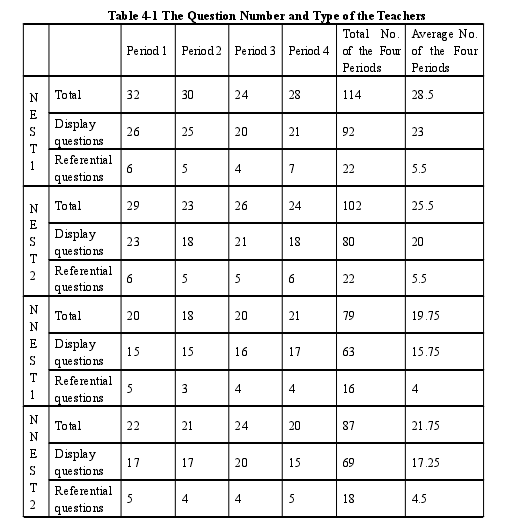联系方式
more本类最新英语论文
- 2024-03-31卡森•麦卡勒斯小说中..
- 2024-03-28美国黑人女性心理创伤思考—..
- 2024-03-27乔治·艾略特《织工马南》中..
- 2024-03-21超越凝视:论《看不见的人》..
- 2024-03-19《哈克贝利•费恩历险..
- 2024-03-13心灵救赎之旅——从凯利的三..
- 2024-02-22文学地理学视角下的《印度之..
- 2023-05-03英、汉名词短语之形容词修饰..
- 2023-02-07目的论视域下5g—the futur..
- 2022-07-04二语英语和三语日语学习者的..
more热门文章
- 2009-03-31the comparison of family ..
- 2010-04-02英语毕业论文范文 委婉语的..
- 2011-03-17代写英语毕业论文:global ..
- 2009-04-16常用经典英语论文写作句型
- 2009-04-17apa格式 英语论文中的apa格..
- 2015-05-13英语毕业论文范文:marketin..
- 2010-07-26英语毕业论文指导
- 2009-04-21原创优秀英语教学毕业论文范..
- 2010-09-18英语跨文化交际教学硕士毕业..
- 2010-12-26“迷惘”的主题之评析《永别..
more留学论文写作指导
- 2024-03-31卡森•麦卡勒斯小说中..
- 2024-03-28美国黑人女性心理创伤思考—..
- 2024-03-27乔治·艾略特《织工马南》中..
- 2024-03-21超越凝视:论《看不见的人》..
- 2024-03-19《哈克贝利•费恩历险..
- 2024-03-13心灵救赎之旅——从凯利的三..
- 2024-02-22文学地理学视角下的《印度之..
- 2023-05-03英、汉名词短语之形容词修饰..
- 2023-02-07目的论视域下5g—the futur..
- 2022-07-04二语英语和三语日语学习者的..
英语专业听说课堂中外教师课堂提问对比研究 [3]
论文作者:www.51lunwen.org论文属性:硕士毕业论文 thesis登出时间:2017-10-07编辑:lgg点击率:5275
论文字数:38594论文编号:org201709301849296979语种:英语 English地区:中国价格:$ 66
摘要:本文是英语毕业论文,对于大多数学生来说,课堂是学习英语不可缺少的地方。在有限的课时,教师提问学生回答是老师和学生之间的相互作用的重要方式,教师提问也鼓励学生开口说英语,练习和表达自己。
4.1 The Similarities and Differences between Native ......29
4.2 The Reasons for the Differences..... 43
4.3 Students’ and Teachers’ Views on Classroom Questioning.....44
Chapter V Conclusion........58
5.1 Major Findings........ 58
5.2 Implication.......60
5.3 Limitations and Suggestions........... 62
Chapter IV Results and Discussion
The findings concerning the three research questions will be provided in thischapter. This chapter will develop into three parts: the similarities and differences ofnative and non-native English-speaking teachers, the reasons of the differences,students’ and teachers’ views towards classroom questioning.
4.1 The Similarities and Differences between Native and Non-nativeEnglish-speaking
Teachers
The results show that native and non-native English-speaking teachers havesome similarities and differences in classroom questioning. Based on classroomobservation, student questionnaire and teacher interview, those similarities anddifferences are discussed in six layers: question number and type, wait-time,questioning distribution, ways of eliciting answers, teachers’ modification of questionand teachers’ feedback.There are a number of ways to classify the questions that teachers pose in class.By far, the most widely-used categories are presented by Long & Sato (1983): displayquestions and referential questions. A display question refers to a question that thequestioner knows the answer. A referential question, however, refers to a question thatthe questioner does not know the answer. The purpose of a display question is toconsolidate the learning outcomes of the learner and to practice the language. The aimof a referential question, in contrast, is to seek information that the questioner doesnot know.The researcher observed the English listening and speaking classes of fourteachers and each for four periods of classes. During the observation, the researchertakes note and records the results in Classroom Observation Scale. The results areshowed in Table 4-1.

Conclusion
Major findings of the research will be summarized in this chapter, theimplication for the teachers, limitation of the study and suggestions for the futurestudies will also be put forward.The current study is an attempt to compare the classroom questioning betweenNESTs and NNESTs and explore students’ and teachers’ views towards it throughclassroom observation, questionnaire and interview. Major findings of the study areconcluded as follows:Firstly, NESTs and NNESTs have similarities as well as differences in classroomquestioning in listening and speaking class. When it comes to question number andtype, NESTs provide more questions in class than NNESTs. However the percentagesof display questions and referential questions NESTs and NNESTs asked are almostthe same. In terms of wait-time, both NESTs and NNESTs are able to give theirstudents sufficient time to think and wait patiently for students to answer, but NESTsprovide more wait-time than NNESTs. As for questioning distribution, both NESTsand NNESTs try to take care of all the students, but in some occasions, they are likelyto question the students who are extroverted and active in class. In terms of ways ofeliciting answers, nominating is the most predominant way of elic本论文由英语论文网提供整理,提供论文代写,英语论文代写,代写论文,代写英语论文,代写留学生论文,代写英文论文,留学生论文代写相关核心关键词搜索。

 英国
英国 澳大利亚
澳大利亚 美国
美国 加拿大
加拿大 新西兰
新西兰 新加坡
新加坡 香港
香港 日本
日本 韩国
韩国 法国
法国 德国
德国 爱尔兰
爱尔兰 瑞士
瑞士 荷兰
荷兰 俄罗斯
俄罗斯 西班牙
西班牙 马来西亚
马来西亚 南非
南非






